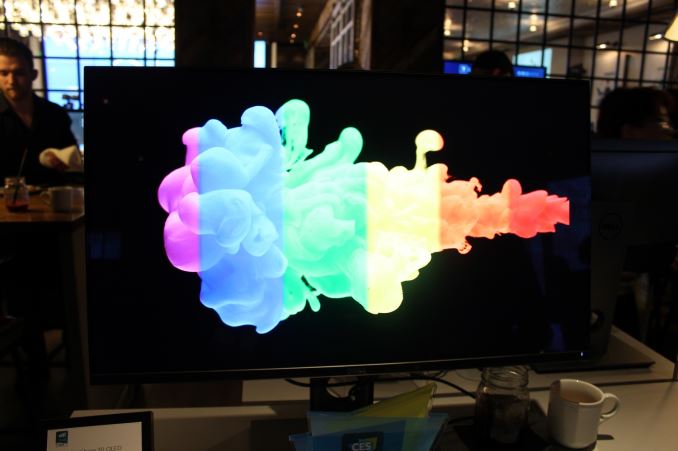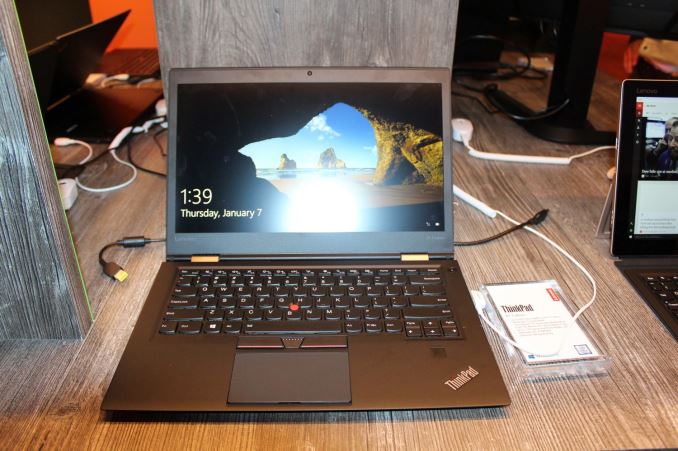CES 2016 Roundup: Total Editor Recall
by AnandTech Staff on January 26, 2016 11:00 AM EST- Posted in
- Trade Shows
- CES 2016
Senior Laptop Editor, Brett Howse
Every year we converge on Las Vegas to see all the new technology announcements from the world. The show is massive, and there is always a struggle to see as much as you can in the limited time available. This year I’ve stepped up as the senior laptop editor so there was plenty for me to cover in the couple of days I had boots on the ground, so to speak.
I think for me the most amazing announcement was the incredible number of devices that were available with OLED displays. I’ve long been a fan of the deep black levels OLED can produce and I’ve been wanting to see some on notebooks. We got that and more. There were several notebooks announced with OLED including the Lenovo ThinkPad X1 Yoga, the HP x360, and the Alienware 13, but I think the most impressive was the 30-inch Dell UltraSharp display. The price is very high but new uses of technology always start that way.
OLED is not the holy grail either. It has power draw issues on high APL workflows which is kind of the standard in the PC space. But as a first step into the PC sector, I was very impressed with the displays on all of the devices. It doesn’t even appear that the price premium is going to be that bad on the notebooks so hopefully we will see more innovation with these displays.
Another trend I’ve noticed, and this didn’t start at CES, is just how thin and light powerful notebooks have become. Everyone was keen to show off their latest notebooks based on Skylake, and it’s fairly stunning how much computer you can pack into such a small body. The LG gram is a great example of this. LG decided to use traditional Ultrabook parts in a 15-inch chassis, and when you see a 15-inch notebook under three pounds, it’s almost like it's not there. Very impressive.
Often the trade off of this is battery life though, and with the rare exception many companies have been going the smartphone route where thin and light trumps extra battery life. But even with that said, notebooks like the ThinkPad X1 Carbon got thinner and lighter this year but also increased battery capacity. High density batteries come into play here. I think it’s going to be a trend we continue to see but hopefully device efficiency makes up the difference. Everyone has different needs as far as battery life, and even the worst performers in 2016 last far longer than notebooks only a couple of years old.
The final thing I want to bring up is the decline in the PC market. Depending on what numbers you look at, the PC market dropped 6-10% in 2015 when looking at unit sales. I suppose that’s not a huge surprise considering how we interact with different devices now, and we have not seen an increase in system requirements for Windows since Vista in 2007, so old computers are still getting by. I’m as guilty of this as anyone, since I just upgraded to an i7-6700K system from an i7-860 system I believe I built in 2009. My old system was still good and rarely did I wish for more performance. Tablets have also taken some of our usage share, and with their light weight operating systems people are already finding they have a long lifespan. But despite the bad news about PC sales, it actually has been very good for consumers.
The quality of laptops released at CES were clearly a step ahead of what they have been in the past. In the past quality was secondary to quantity, but with the drop in volume, everyone has had to step up their game. Build quality, display quality, and performance have all taken a big step forward, especially for companies competing in the premium space. Users also want a nice looking laptop, and we saw the Dell XPS 13 come along last year and set the bar pretty high. Dell then took the styling and applied it to the XPS 15 to great effect, as well as their new Latitude 13. No one else is standing idle though, and there have been some excellent designs by other companies as well like the HP x360 and Lenovo 900.
So although the numbers suggest an industry in decline, I saw plenty at CES to make me hopeful for the future that at least the devices are improving for those that want them.













44 Comments
View All Comments
Brandon Chester - Tuesday, January 26, 2016 - link
The fact that it was LG is exactly why it didn't advance OLED as a category. It's a market with basically one vendor. Everyone else is still pushing LCD.Nintendo Maniac 64 - Tuesday, January 26, 2016 - link
Well that's kind of expected when the majority of the competition are also the incumbent leaders when it comes to flat-panel market-share (that being Samsung and Innolux).I mean, there's a reason you don't see Toyota going all-in on electric vehicles - because they're in incumbent when it comes to market-share of the internal combustion engine.
boeush - Tuesday, January 26, 2016 - link
I see a need for a new high-bandwidth optical cable.Intel always envisioned Thunderbolt evolving toward optical signalling (going at least back to the days when it was code-named LightPeak). With VR goggles potentially pushing 8k+ x 2 at 90 Hz in the future, with external graphics enclosures having potential for crossfire/SLI needing at least the equivalent of 2 x PCIe3 x8 (or even x16) for optimal performance (never even mind the upcoming PCIe4 standard), and with next-gen storage (like 3D XPoint, etc) promising much higher bandwidths for DAS systems - it seems to me the time is right for a thin, long, light and flexible optical cable and accompanying compact transmitter/receiver standard capable of moving data at TB/s rates.
Surely there has to be some development occurring along these lines?
Ikefu - Tuesday, January 26, 2016 - link
The Razer Core Thunderbolt GPU box has me very intrigued. As a traveling engineer I'm always fighting the battle between a bulky laptop I have to drag in to the field with me or a sleek laptop that is under-powered for development and games at a desk. A Dell XPS 15 with a Razer Core would be a juicy option indeed.lmc5b - Tuesday, January 26, 2016 - link
Page 2, line 2: "and there always" should be "and there is always" I think.Lolimaster - Tuesday, January 26, 2016 - link
The easy route to detect an apple fanatic:-Brandon Chester in his twenties.
-Bash OLED just to mention microLED after Apple bought the company instead of keep face mentioning maybe Sony's CrystalLED.
Brandon Chester - Wednesday, January 27, 2016 - link
1. Nowhere was OLED bashed. In fact, I said it will become the dominant tech in all mobile devices, which is quite a testament to its quality. It simply has inherent issues with aging, and that will cause issues in TVs.2. CLED was a one time Sony tech demo. MicroLED is not exclusive to Apple at all, and to my knowledge the only relation Apple has even had with it is buying a small company working with MicroLED around two years ago. If anything, using the example of something done by Sony as a CES tech demo instead of an actually disruptive upcoming technology would be the wrong way to go.
3. I'm not in my twenties.
at80eighty - Tuesday, January 26, 2016 - link
Loved this.You guys should make this a running thing. something like a State of Tech; maybe a bi-monthly / quarterly cadence? get all your editors to chip in.
random2 - Wednesday, January 27, 2016 - link
"Covering PC to smartphone to TV to IoT to the home and the car,..."OK, I give....What's loT?
"Firstly was storage - Mushkin showed us an early PVT board...."
PVT? Pressure, volume, temperature? Price, volume, trend? Position, velocity, and time? Paroxysmal Ventricular Tachycardia?
I stay out of the loop for a while and I have to take a course in leet speak to read an Anandtech article.
Ian Cutress - Wednesday, January 27, 2016 - link
IoT = Internet of Things - basically can you put a chip into it that'll connect to the web for monitoring/control. It's a term that started around 2008.PVT = Production Validation Test, one of the sample stages for validation before mass production. This one is as old as mass production in electronics.
But point taken, I'll expand acronyms in future on first use :)